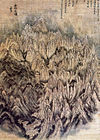Hello !
My first interest in Korean Art, History and language starts by the history of Joseon Dynasty and a bit further Noe-Confucius. The fourth king of Joseon “Se-Jong” and his creation of the amazing Korean alphabet got me thinking that these years the people know about Einstein or other genius people but no body knows of someone like king “Se-Jong” who creates one of the greatest alphabet system of the world and in a country that kind a rules the technology of the world … anyway Regarding the copyright that I need to sort out soon, I will put my essays that I published 🙂
My works are in the list below:
“Genuis King”
(Based on the story of king “Se-Jong” and the creation of Korean alphabet)
“Noe-Confucius, theories into visual and drama”
(works on the effect of Noe-Confucius movement into the art and drama and beside my thesis I have an 8 series documentary screenplay and production plan on the golden times of Joseon Dynasty and Noe-Confucius movement)
Korean- Wave in historical movies and dramas success from 1990s to the present
How does the Korean-Wave (Hallyu) media industry introduce Korean history and culture globally?
The Role of Korean wave in Media in 1990s to Introducing Arirang Globally
How Korean media in 1990s mainly introduced Arirang globally and what was the role of Korean Wave (Hallyu) to achieve this big success?
P.S I love the art of Joseon Dynasty specially paintings and below I put some information and works:
Joseon Dynasty
The influence of Confucianism superseded that of Buddhism in this period, however Buddhist elements remained and it is not true that Buddhist art declined, it continued, and was encouraged but not by the imperial centres of art, or the accepted taste of the Joseon Dynasty publicly; however in private homes, and indeed in the summer palaces of the Joseon Dynasty kings, the simplicity of Buddhist art was given great appreciation – but it was not seen as citified art.
While the Joseon Dynasty began under military auspices, Goryeo styles were let to evolve, and Buddhist iconography (bamboo, orchid, plum and chrysanthemum; and the familiar knotted goodluck symbols) were still a part of genre paintings. Neither colours nor forms had any real change, and rulers stood aside from edicts on art. Ming ideals and imported techniques continued in early dynasty idealized works.
Early dynasty painters include:
Mid-dynasty painting styles moved towards increased realism. A national painting style of landscapes called “true view” began – moving from the traditional Chinese style of idealized general landscapes to particular locations exactly rendered. While not photographic, the style was academic enough to become established and supported as a standardized style in Korean painting.

Joseon Dynasty painting by Owon.
Mid-dynasty painters include:
- Hwang Jip-jung (born 1553)
The mid to late Joseon dynasty is considered the golden age of Korean painting. It coincides with the shock of the collapse of Ming dynasty links with the Manchu emperors accession in China, and the forcing of Korean artists to build new artistic models based on nationalism and an inner search for particular Korean subjects. At this time China ceased to have pre-eminent influence, Korean art took its own course, and became increasingly distinctive.
The list of major painters is long, but the most notable names include:
- Jeong Seon (1676–1759), a literati painter influenced by the Wu school of the Ming dynasty in China; much taken by the Diamond mountain landscape.
- Yun Duseo (1668–1715), a portraitist.
- Kim Hong-do (1745–1818?) aka Danwon in his pen name, did highly coloured crowded scenes of common and working-class people in many natural work activities – his paintings have a post-card or photographic realism in a palette of whites, blues, and greens. There is little if any calligraphy in his works; but they have a sense of humour and variety of gestures and movement that make them highly imitated to this day.
- Shin Yun-bok (1758-?) aka Hyewon in his pen name, a court painter who did paintings often of the scholarly or yangban classes in motion through stylized natural settings; he is famous for his strong reds and blues, and grayish mountainscapes.
- Jang Seung-eop (1843–1897) aka Owon in his pen name, was a painter of the late Joseon Dynasty in Korea and one of three great wons of Joseon Korea.
What calligraphy used is often discreetly done.
Other important artists of the “literati school” include:
Gallery
-
Ahn Gyeon (?-?), A Dream of Amusement in the Garden of Peach Blossoms, 1447, Tenri University Central Library.
-
Yi Ahm (1499-?), Mother Dog, 15th century, National Museum of Korea.
-
Jeong Seon (1676–1759), A View of Geumgang, 1734, Hoam Gallery.
-
Kim Hong-do (1745-?), Two Men Wrestle, 18th century, National Museum of Korea.
-
Shin Yun-bok (1758-?), A Boat Ride, 1805, Gansong Art Gallery.
-
Jo Hee-ryong (1797–1859), A House amongst Apricot Trees, Gansong Art Gallery.
Artists during the Japanese occupation
Korean artists from the middle 1880s til 1945, when Korea was freed by the allies after the unconditional surrender of Japan, had a very difficult time.
From the 1880s onward, The Japanese admired Western art and looked down on traditional Korea art. However, Japan philosopher Yanagi Sōetsu appreciates Korean folk art, protected the Korean art.
Japan held an exhibition of the Korea art and produced many Koreans young artists such as Park Su-geun. To this date there has not been a retrospective show of the hidden art under Japanese occupation, or a discussion of the conflicts between those who were forced into compromise under Japanese artistic demands. It is an issue of great sensitivity, with artists who studied and worked in Japan and painted in the Japanese style forced into self-defense and justification of compromise without other alternatives.
Bridging the late Joseon dynasty and the Japanese occupation period were noteworthy artists such as:
- Chi Un-Yeong (1853–1936)
and others.
20th century Artists:
New wave Artists:
21st Century Artists:









 GoodReads
GoodReads